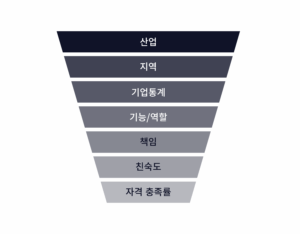설문조사 선별질문이란?
선별질문은 모든 설문조사에서 가장 중요한 부분임에도 과소평가되거나 불필요하다고 여겨지는 경우가 많습니다. 이런 함정에 빠져서는 안 됩니다. 시간을 들여 선별질문을 작성해, 목적에 부합하는 전문가만 설문조사에 참여하게 하는 것이 좋습니다.
효과적인 설문조사 선별질문 작성하기
그렇다면 어떻게 선별질문 섹션을 설계해야 부적절한 응답자를 걸러낼 수 있을까요? 퍼널(funnel) 접근법을 이용하면 됩니다. 퍼널 접근법은 넓은 범주의 질문으로 시작해 점차 세세한 질문을 던져 원하는 응답자를 확보할 때까지 걸러내는 방식입니다. 데이터를 왜곡시킬 수 있는 응답자를 먼저 걸러내지 않고 주제에 대한 질문을 바로 던지는 것은 바람직하지 않습니다.
예를 들어, 타겟 응답자가 의료 시스템 마케팅 디렉터라면 ‘마케팅 의사 결정’과 관련된 질문으로 시작해서는 안 됩니다. 그럴 경우 응답자의 설문조사에 대한 인식에 영향을 미쳐 응답의 질이 달라질 수 있습니다.
설문조사 선별질문의 유형
설문조사 선별질문의 유형
- 산업: 산업 관련 질문을 활용하면 설문에 적합한 전문가를 더욱 정확하게 선별할 수 있습니다.
- 예: 귀하의 조직이 속한 주요 산업 부문을 선택하세요.
- 지역: 국가, 지역, 주 또는 대도시 통계 지역 단위로 질문을 던져, 내가 수집한 응답의 지역 분포를 분석할 수 있습니다.
- 예: 다음 중 귀사의 주요 사업 운영 지역으로 간주되는 국가는 어디입니까?
- 기업통계: 정규직 직원 수(FTE), 연간 매출 등을 확인해 필요한 기업 분포를 확보할 수 있습니다. (예: FTE 1,000명 미만과 FTE 1,000명 이상의 비율을 50 대 50으로 하기) 또한, 응답자가 어떤 기업 유형에 속해 있는지도 파악할 수 있습니다.
- 예: 귀사의 연 매출 규모에 가장 가까운 항목을 선택해 주세요.
- 기능/역할: 같은 직책이지만 직함이 다양한 경우, 유사 직함을 정의하는 질문을 포함하면 좋은 응답자 후보를 놓치지 않을 수 있습니다.
- 예: 현재 직무에서 주로 어떤 의사결정을 담당하고 있나요? 전략적 의사결정(예: 회사의 방향 설정, 주요 투자 결정), 운영 관련 의사결정(예: 일상 운영, 프로세스 개선), 전술적 의사결정(예:프로젝트 기획, 자원 배분), 예산 관련 의사결정(예: 재무 승인, 비용 관리)
- 책임: 직함만으로는 그 사람이 평소에 어떤 업무를 수행하는지 파악하기 어려울 수도 있습니다. 따라서, 담당 책임을 묻는 질문을 활용하면 실제 의사결정자로부터 인사이트를 얻을 수 있습니다.
- 예: [특정 구매 또는 전략 영역]에 대한 귀하의 관여도를 1~5점으로 평가해 주세요. (5점: 전적으로 책임이 있음, 1: 전혀 관여하지 않음)
- 친숙도(벤더/브랜드/제품 등): 이 질문으로 응답자가 해당 제품에 대해 알고 있거나 사용해 본 적이 있는지를 확인합니다. 구체적인 질문이기 때문에 선별질문 섹션의 마지막에 넣어야 합니다.
- 예: 귀하 또는 귀사는 현재 [특정 제품/벤더/브랜드]를 사용하고 있나요?
때로는 특정 영역이나 부문에 대한 응답자의 지식수준을 평가하는 것이 중요할 수 있습니다. 이러한 질문을 통해 응답자가 해당 주제에 대해 이야기하는 데 필요한 지식 및 경험을 갖추고 있다는 확신을 얻을 수 있습니다. 이러한 유형의 질문은 ‘친숙도’ 카테고리와 연계하여 활용할 수 있습니다.
좋은 선별질문의 조건
좋은 선별질문은 자연스러운 응답을 이끌어내고, 전체 인터뷰 시간을 크게 늘리지 않아야 합니다. 예를 들어, 자신이 속한 산업이나 지역에 대한 질문은 쉽게 답할 수 있습니다. 또한, 선별질문의 형태를 표준화하면 응답 속도를 높일 수 있습니다.
선별질문을 사용하면 대상별 할당도 가능합니다. 할당이란 사전 설정한 분포를 적용하고 세그먼트당 응답자 수를 모니터링하기 위한 것입니다. 예를 들어, 설문 대상이 의료 시스템 관련 마케팅 의사결정자 50명과 개별 병원의 마케팅 의사결정자 50명인 경우, 선별질문에서 할당을 적용해 응답이 한 영역에 치우치지 않도록 할 수 있습니다. 그렇지 않을 경우, 설문조사에 참가하는 모집단을 모니터링할 때 많은 어려움을 겪을 수 있습니다.
좋은 선별질문을 사용하면 부적절한 응답자는 걸러내면서, 본 설문에 참여할 응답자를 선별하는 기준도 명확히 할 수 있습니다. 그러나 세부 데이터 분석 목적으로 인구통계 또는 기업통계 정보를 수집하는 질문을 선별질문에 포함해서는 안 됩니다. 이런 세분화 질문은 설문 마지막에 배치해, 기준을 충족하지 못하는 전문가가 필요 이상으로 설문조사에 참여하지 않도록 합니다.
주요 기준 중에는 타겟팅이 어려운 것도 있습니다. 이 경우 선별질문이 가장 적합한 전문가만 설문조사에 참여할 수 있도록 도와주는 추가 장치 역할을 합니다.
설문조사 선별질문에서 발생할 수 있는 편향의 유형
잘못 설계된 선별질문은 편향된 결과를 가져올 수 있습니다. 이해하기 쉽고 편파적이지 않은 선별질문을 만들려면 우선 어떤 유형의 편향이 발생할 수 있는지 알아둬야 합니다.
- 유도질문 보통 ‘예/아니오’ 질문의 형태로 응답자가 어떤 답변이 자격 요건을 충족하는지 쉽게 알 수 있습니다. 그보다는 응답자에게 여러 보기를 제시하는 것이 좋습니다. 예를 들어, “헬스케어 마케팅에 대해 아시나요?”라고 묻는 대신, “아래 중 어떤 분야에 대해 잘 알고 계신가요?”라고 물어보는 것이 바람직합니다.
- 복합질문 한 번에 하나 이상의 질문을 던지면, 혼란이 가중되고 데이터의 질도 떨어질 수 있습니다. 예를 들어, “디지털 플랫폼을 관리하는 현직 헬스케어 마케팅 디렉터이신가요?”라고 물으면, 직책, 현직 여부, 직함, 플랫폼 지식을 한꺼번에 물어보게 됩니다. 대신, 이 질문을 세 개의 질문으로 나눠 현직 여부, 직함, 플랫폼 지식을 개별적으로 확인하는 것이 좋습니다.
- 소개란 소개란을 통해 설문조사의 스폰서, 조사 과제, 그리고 찾고 있는 정보를 설명할 수 있습니다. 이러한 소개란을 활용하는 것은 좋으나, 선별질문 섹션 내 위치가 중요합니다. 선별질문보다 앞서 소개란을 표시하면, 응답자가 어떤 답을 해야 하는지 알게 되므로, 선별질문을 거쳐 응답자가 설문 대상으로 선정된 후에 소개란을 제시하세요.
선별질문을 촘촘하게 설계할수록 설문조사 시 더 신중한 응답을 얻을 수 있습니다. 주제에 대해 잘 알고 있는 응답자는 서두르지 않고 질문에 답변할 가능성이 높기 때문입니다. 관련 지식이 부족해 답변이 짧아지는 위험도 덜고, 뛰어난 전문가로부터 포괄적인 응답을 얻을 수 있습니다.
선별질문은 조사에 활용할 수 있는 양질의 응답 및 데이터의 수집 가능성을 높이기 위한 것입니다. 시간을 들여 상세한 선별질문을 작성한다면 향후 분석 또한 쉬워집니다.
GLG 설문조사는 가장 빠르고 효율적으로 현장에서 전략을 테스트할 수 있는 방법입니다. 또한 GLG 리서치 전문팀에서 범위 설정, 선별질문 및 질문지 설계, 패널 선정, 품질 검토, 데이터 해석, 데이터 가시화 등 프로젝트의 모든 단계를 지원합니다.
잠재고객의 인사이트가 필요하신가요? 아래의 양식을 작성해 바로 설문조사를 시작해 보세요.
설문조사 시리즈의 다른 글도 확인해 보세요.




